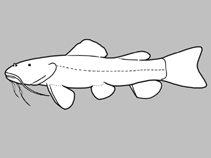Microglanis xerente Ruiz, 2016
Uploaden van uw Foto's en video's
Google afbeeldingNo image available for this species;
drawing shows typical species in Pseudopimelodidae.
Google afbeeldingNo image available for this species;
drawing shows typical species in Pseudopimelodidae.
Classificatie / Names Lokale namen | Synoniemen | Catalog of Fishes(Genus, Soort(en)) | ITIS | CoL | WoRMS | Cloffa
> Siluriformes (Catfishes) > Pseudopimelodidae (Bumblebee catfishes, dwarf marbled catfishes) > Batrochoglaninae
Etymology: Microglanis: Greek, mikros = small + Greek, glanis = a fish that can eat the bait without touching the hook; a cat fish (Ref. 45335).
Eponymy: The Xerente ethnic group are the native indigenous people who live along the Rio Tocantins basin, Brazil. (Ref. 128868), visit book page.
Etymology: Microglanis: Greek, mikros = small + Greek, glanis = a fish that can eat the bait without touching the hook; a cat fish (Ref. 45335).
Eponymy: The Xerente ethnic group are the native indigenous people who live along the Rio Tocantins basin, Brazil. (Ref. 128868), visit book page.
Environment: milieu / climate zone / depth range / distribution range Ecologie
; zoet water demersaal. Tropical
Verspreiding Landen | FAO regio's | Ecosystemen | Voorkomen | Point map | Introducties | Faunafri
South America: Brazil.
Grootte / Gewicht / Leeftijd
Korte beschrijving Determinatiesleutels | Morfologie | Morfometrie
Dorsale stekels (totaal) : 2; Dorsale zachte stralen (totaal) : 6; Anale zachte stralen: 11 - 12. This species is distinguished from its congeners by the following characters: with a wide brown stripe in the dorsal and caudal fins in specimens larger than 2.5 cm SL (inconspicuous or absent in small specimens) and by the presence of neuromasts surrounded by melanophores forming small black dots aligned in four rows on head, one on nape, one posterior to nape, and three horizontal on trunk; differs further by the presence or absence of a light band on nape (some paratypes have a small and irregular pale brown blotch on the region nuchal), supraoccipital process not contacting the anterior nuchal plate, width of mouth 34-47% HL (vs. 47-63 in M. carlae, M. cibelae, M. cottoides, M. iheringi, M. malabarbai, M. minutus, M. reikoae, M. nigripinnis, M. oliveirai, M. parahybae, M. pataxo, M. pleriqueater, M. sparsus, M. variegatus), and greater caudal peduncle length 15.9-17.9% SL (vs. 10.0-15.9 in M. carlae, M. cibelae, M. cottoides, M. eurystoma, M. iheringi, M. maculatus, M. malabarbai, M. nigripinnis, M. parahybae, M. pataxo, M. pellopterygius, M. poecilus, M. secundus, M. variegatus) (Ref. 130492).
The specimens of were collected from small watercourses draining the Cerrado biome, with riparian forest relatively well preserved and usually with buriti palm trees (Mauritia flexuosa) present on the margins of the stream and around these watercourses, there are usually livestock pastures. At the córrego Narciso, there are small rapids, sandy patches, and pools, usually presenting leaves, fallen tree branches, and submerged leaf-litter at the bottom (Ref. 130492).
Levenscyclus en paargedrag Maturiteit | Voortplanting | Paaien | Eieren | Fecunditeit | Larven
Hoofdreferentie
Upload your references | Referenties | Coördinator : Shibatta, Oscar Akio | Medewerkers
Ruiz, W.B.G., 2016. Three new species of catfishes of the genus Microglanis from Brazil (Teleostei: Pseudopimelodidae), with comments on the characters used within the genus. Ichthyol. Explor. Freshwat. 27(3):211-232.
[22 Nov. 2016 is the publication date without ZooBank registration, 18 Nov. with an electronic prepublication date; this serves as the date for Oct., Nov. and Dec.] (Ref. 130492)
Status op de Rode Lijst van het IUCN (Ref. 130435: Version 2024-2)
Onvoldoende gegevens (DD) ; Date assessed: 02 February 2021
CITES
Not Evaluated
Gevaar voor de mens
Harmless
Gebruik door de mens
FAO - Publication: search | FishSource |
Meer informatie
Trophic ecology
Voedselitems
Dieetsamenstelling
Voedselconsumptie
Food rations
Predatoren
Voedselitems
Dieetsamenstelling
Voedselconsumptie
Food rations
Predatoren
Ecology
Ecologie
Ecologie
Population dynamics
Groeiparameters
Max. ages / sizes
Length-weight rel.
Length-length rel.
Lengtefrequenties
Massaconversie
Rekrutering
Abundantie
Groeiparameters
Max. ages / sizes
Length-weight rel.
Length-length rel.
Lengtefrequenties
Massaconversie
Rekrutering
Abundantie
Life cycle
Voortplanting
Maturiteit
Maturity/Gills rel.
Fecunditeit
Paaien
Spawning aggregations
Eieren
Ontwikkeling van de eieren
Larven
Larvale populatiedynamiek
Voortplanting
Maturiteit
Maturity/Gills rel.
Fecunditeit
Paaien
Spawning aggregations
Eieren
Ontwikkeling van de eieren
Larven
Larvale populatiedynamiek
Anatomy
Kieuwoppervlak
Brain
Otolith
Kieuwoppervlak
Brain
Otolith
Physiology
Body composition
Nutrients
Zuurstofverbruik
Zwemtype
Zwemsnelheid
Visual pigments
Fish sound
Diseases & Parasites
Toxicity (LC50s)
Body composition
Nutrients
Zuurstofverbruik
Zwemtype
Zwemsnelheid
Visual pigments
Fish sound
Diseases & Parasites
Toxicity (LC50s)
Genetics
Genetica
Heterozygosity
Erfelijkheid
Genetica
Heterozygosity
Erfelijkheid
Human related
Aquaculture systems
Aquacultuurprofielen
Kweeklijnen
Ciguatera cases
Stamps, coins, misc.
Aquaculture systems
Aquacultuurprofielen
Kweeklijnen
Ciguatera cases
Stamps, coins, misc.
Tools
E-boek | Veldgids | Lengtefrequentie Tool | Levenscyclus tool | Verspreidingskaart | Classification Tree
| Catch-MSY |
Speciale rapporten
Bekijk gegevens voor het houden in een aquarium | Bekijk Fact Sheets voor de soort | Bekijk Aquacultuur Fact Sheets
Download XML
Internetbronnen
AFORO (otoliths) | Aquatic Commons | BHL | Cloffa | BOLDSystems | Websites from users | Bekijk FishWatcher | CISTI | Catalog of Fishes: Genus, Soort(en) | DiscoverLife | ECOTOX | FAO - Publication: search | Faunafri | Fishipedia | Fishtrace | GenBank: genoom, nucleotide | GloBI | Google Books | Google Scholar | Google | IGFA World Record | MitoFish | Otolith Atlas of Taiwan Fishes | PubMed | Reef Life Survey | Socotra Atlas | Tree of Life | Wikipedia: ga naar, zoek | World Records Freshwater Fishing | Zoobank | Zoological Record
Estimates based on models
Fylogenetische diversiteitsindex (Ref. 82804): PD50 = No PD50 data [Uniqueness, from 0.5 = low to 2.0 = high].
Bayesian length-weight: a=0.00741 (0.00314 - 0.01747), b=3.10 (2.90 - 3.30), in cm total length, based on LWR estimates for this (Sub)family-body shape (Ref. 93245).
Trofisch niveau (Ref. 69278): 3.2 ±0.4 se; based on size and trophs of closest relatives
Fishing Vulnerability (Ref. 59153): Low vulnerability (10 of 100).




